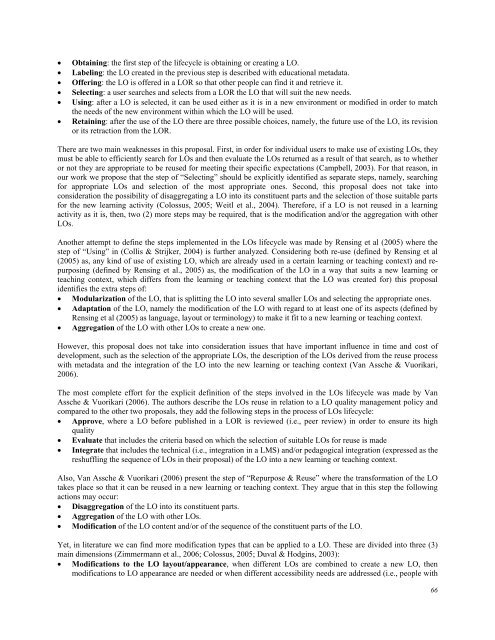October 2011 Volume 14 Number 4 - Educational Technology ...
October 2011 Volume 14 Number 4 - Educational Technology ...
October 2011 Volume 14 Number 4 - Educational Technology ...
You also want an ePaper? Increase the reach of your titles
YUMPU automatically turns print PDFs into web optimized ePapers that Google loves.
Obtaining: the first step of the lifecycle is obtaining or creating a LO.<br />
Labeling: the LO created in the previous step is described with educational metadata.<br />
Offering: the LO is offered in a LOR so that other people can find it and retrieve it.<br />
Selecting: a user searches and selects from a LOR the LO that will suit the new needs.<br />
Using: after a LO is selected, it can be used either as it is in a new environment or modified in order to match<br />
the needs of the new environment within which the LO will be used.<br />
Retaining: after the use of the LO there are three possible choices, namely, the future use of the LO, its revision<br />
or its retraction from the LOR.<br />
There are two main weaknesses in this proposal. First, in order for individual users to make use of existing LOs, they<br />
must be able to efficiently search for LOs and then evaluate the LOs returned as a result of that search, as to whether<br />
or not they are appropriate to be reused for meeting their specific expectations (Campbell, 2003). For that reason, in<br />
our work we propose that the step of “Selecting” should be explicitly identified as separate steps, namely, searching<br />
for appropriate LOs and selection of the most appropriate ones. Second, this proposal does not take into<br />
consideration the possibility of disaggregating a LO into its constituent parts and the selection of those suitable parts<br />
for the new learning activity (Colossus, 2005; Weitl et al., 2004). Therefore, if a LO is not reused in a learning<br />
activity as it is, then, two (2) more steps may be required, that is the modification and/or the aggregation with other<br />
LOs.<br />
Another attempt to define the steps implemented in the LOs lifecycle was made by Rensing et al (2005) where the<br />
step of “Using” in (Collis & Strijker, 2004) is further analyzed. Considering both re-use (defined by Rensing et al<br />
(2005) as, any kind of use of existing LO, which are already used in a certain learning or teaching context) and repurposing<br />
(defined by Rensing et al., 2005) as, the modification of the LO in a way that suits a new learning or<br />
teaching context, which differs from the learning or teaching context that the LO was created for) this proposal<br />
identifies the extra steps of:<br />
Modularization of the LO, that is splitting the LO into several smaller LOs and selecting the appropriate ones.<br />
Adaptation of the LO, namely the modification of the LO with regard to at least one of its aspects (defined by<br />
Rensing et al (2005) as language, layout or terminology) to make it fit to a new learning or teaching context.<br />
Aggregation of the LO with other LOs to create a new one.<br />
However, this proposal does not take into consideration issues that have important influence in time and cost of<br />
development, such as the selection of the appropriate LOs, the description of the LOs derived from the reuse process<br />
with metadata and the integration of the LO into the new learning or teaching context (Van Assche & Vuorikari,<br />
2006).<br />
The most complete effort for the explicit definition of the steps involved in the LOs lifecycle was made by Van<br />
Assche & Vuorikari (2006). The authors describe the LOs reuse in relation to a LO quality management policy and<br />
compared to the other two proposals, they add the following steps in the process of LOs lifecycle:<br />
Approve, where a LO before published in a LOR is reviewed (i.e., peer review) in order to ensure its high<br />
quality<br />
Evaluate that includes the criteria based on which the selection of suitable LOs for reuse is made<br />
Integrate that includes the technical (i.e., integration in a LMS) and/or pedagogical integration (expressed as the<br />
reshuffling the sequence of LOs in their proposal) of the LO into a new learning or teaching context.<br />
Also, Van Assche & Vuorikari (2006) present the step of “Repurpose & Reuse” where the transformation of the LO<br />
takes place so that it can be reused in a new learning or teaching context. They argue that in this step the following<br />
actions may occur:<br />
Disaggregation of the LO into its constituent parts.<br />
Aggregation of the LO with other LOs.<br />
Modification of the LO content and/or of the sequence of the constituent parts of the LO.<br />
Yet, in literature we can find more modification types that can be applied to a LO. These are divided into three (3)<br />
main dimensions (Zimmermann et al., 2006; Colossus, 2005; Duval & Hodgins, 2003):<br />
Modifications to the LO layout/appearance, when different LOs are combined to create a new LO, then<br />
modifications to LO appearance are needed or when different accessibility needs are addressed (i.e., people with<br />
66

















